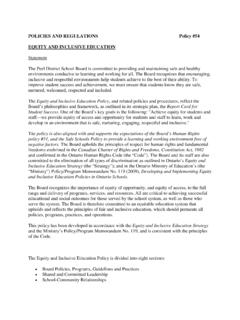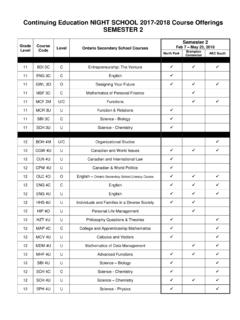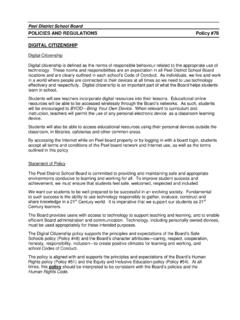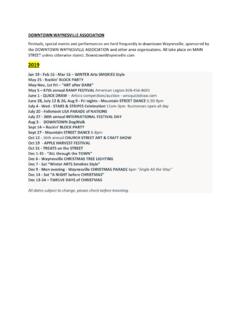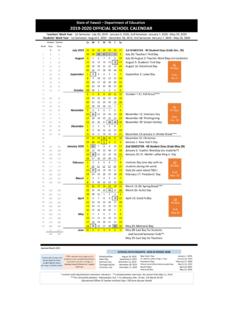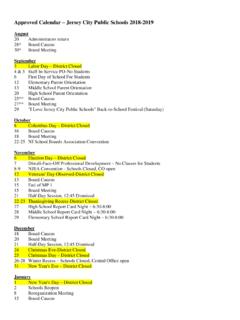Transcription of Holy Days and Holidays Calendar JULY 1, 2017 – DECEMBER …
1 Holy days and Holidays Calendar july 1, 2017 DECEMBER 31, 2018 Aboriginal spiritualityNative cultures have practiced and maintained their spirituality over centuries through ceremonies, customs and traditions that are an integral part of their being. The Supreme Being, the creator, is a fundamental figure in their religious pursuits. Spirituality for Aboriginal people is closely linked to Nature and Mother Earth. In their quest for spirituality, they strive for balance and harmony in their lives. Their spiritual and cultural life is interconnected. Followers of Aboriginal spirituality celebrate seasonal Bah u ll h (1817-1892) founded the Bah faith on the belief of the oneness of God, religion and humanity. Adherents value universal principals such as love, equality, social justice, honesty, kindness etc. while accepting social and scientific changes in their day-to-day lives.
2 Followers of the faith take personal responsibility for their spiritual growth. The Bah faith is governed by spiritual assemblies made up of nine or more members and does not have clergy to guide the Bah Calendar , there are 19 months of 19 days each with four intercalary days (five in leap year). Each month represents an attribute of God. The first month starts with the New Year (March 21) and the last ends with 19 days fast. The Bah day starts at Gautam, the first Buddha, founded Buddhism in the 6th century BCE in Northern India. Two major forms of Buddhism evolved as Buddhism spread across Asia. The Theravada (southern) tradition is found in Burma, Cambodia, India, Laos, Malaysia, Singapore, Sri Lanka, Thailand and parts of Vietnam. The Mahayana and Vajrayana (northern) traditions are found in China, India, Japan, Korea, Mongolia, Tibet and Vietnam.
3 Buddhist teachings guide followers to attain liberation from rebirth through Dharma (Four Noble Truths and the Eightfold Noble Path) and Karma (action with cause and effect). Buddhist calendars vary based on the diverse traditions of the adherents school of thought. This Calendar reflects major dates in all three of the Buddhist follow the life and teachings of Jesus, also called Christ. Christianity shares its roots and some religious texts with Judaism. Jesus was born a Jew. His followers spread Christianity after his death. It is the world s largest religion. There are many denominations, traditions and churches within Christianity. Three main branches of the faith are Roman Catholics, Eastern Orthodox and Protestant. Both the Old and New Testaments guide followers in their spiritual quest. Christians believe in one God, the Holy Trinity and divinity of Christ.
4 Adherents follow either the Julian or Gregorian also called Sanatana Dharma, is the world s oldest organized religion. It evolved over many centuries in the Indian subcontinent and has no single founder or scripture. Adherents believe in one omnipresent, omnipotent, omniscient God. Followers refer to a number of holy texts Vedas, Purana, Gita, Ramayana, Mahabharata and may worship many male and female manifestations of God either in a temple or at home. Hinduism s core beliefs include: Dharma (righteous practices) Karma (action with cause and effect) Moksha (liberation from cycle of rebirth) Atman (eternal soul) Ahimsa (non-violence) Bhakti (devotion) Jnana (knowledge for spiritual enlightenment)The Hindu Calendar Vikram Samvat and Panchang uses both lunar and solar , meaning peace in Arabic, was revealed through the Prophet Muhammad.
5 The message is recorded in the Quran, which is the holiest book for followers of Islam. Muslims believe in submission to one God (Allah), Muhammad as his messenger, angels of God, holy books revealed to mankind, other prophets (Adam to Jesus), the day of judgement and resurrection after death. Followers of the faith have five duties (Pillars of Islam) to perform. Declaration of faith Five prayers daily Fasting in the month of Ramadan Payment of Zakat (annual charity) Hajj (pilgrimage to Mecca) at least once during their lifetimeSunni and Shia are the two main schools of Islam. All Muslims follow a code of behaviour that clearly lays out what is Halal (acceptable/permitted) and what is Haram (prohibited/unacceptable) in their daily lives. Islam follows a lunar Hijri was founded on the teachings of 24 Tirthankaras (liberated and enlightened persons) of whom Vardhamana Mahavira was the last.
6 The religion has its roots in the Indian sub-continent. Jain philosophy provides a way of life for adherents. Shwetamber and Digamber are the two divisions of Jainism. These two sects differ in some of their religious beliefs, interpretations of scripture and daily and ascetic practices. Jains believe in: Jiva (eternal soul) Ahimsa (non-violence) Veganism Aparigraha (non-acquisition) Karma (cause and effect action) Samsar (cycle of transmigration, birth and death) Anekantvada (multiplicity of views) Moksha (liberation from cycle of birth)Jains fast regularly during the course of a year and also during many festivals and holy days . Jains follow the Vir Nirvan Smavat Calendar with its roots in the Hindu is a monotheistic faith. Followers believe that God entered into a covenant with Abraham, and it was later renewed with Moses and the Jewish people to reveal his laws and teachings through the Torah.
7 The Jewish people practice these teachings in their worship and customs. The synagogue is their place of worship. Jews observe the Sabbath weekly, beginning at sunset on Friday and ending at sunset on Saturday. It is the time for spiritual reflection for adherents and they suspend work for the day. Followers of the faith may pray three times morning, afternoon and night each day. Many Jews observe kashrut (or kosher) dietary rules. The Jewish faith is divided into groups depending on adherents religious beliefs and practices. Some of these include Orthodox, Conservative, Reform and Reconstructionist. The Jewish Calendar is a combined lunar and solar Calendar . The holy days may be celebrated either for a day or over two days based on adherent s religious was founded by Guru Nanak (1469-1539). The religion was further developed and defined by nine gurus that came after him and has its roots in the Indian sub-continent.
8 Holy scriptures called Guru Granth Sahib have guided adherents spiritually after the ten gurus. Sikhs believe in one Supreme Being. The key beliefs of Sikhism include: Oneness of humanity the release from birth-cycles through enlightenment worship, meditation and service rejection of caste system, rituals and idol-worship Khalsa (baptized) Sikhs are required to follow Reht Maryada (the Sikh code of conduct) at all times. Reht Maryada includes both the religious and social practices for Sikhs. The Sikh Calendar was modified in 1999 and has moved from lunar to tropical solar calculations. Some groups within the faith continue to use the previous Calendar and therefore some holy-day celebrations may vary based on adherent s is a newly revived religion with roots in pre-Christian religious beliefs, traditions and practices of Europe.
9 Wiccans worship the one Supreme Being and its two aspects male and female equally. The faith also recognizes many other deities venerated from ancient times. Earth-centered practices and harmony with nature are important beliefs of the faith. Followers believe in Karma (actions with cause and effect)and reincarnation. Many Wiccans are members of covens (local Wicca groups). They gather for worship in sacred circles. Most rituals of the faith relating to life cycle and seasonal changes are held in a circle outdoors when possible. Wiccans celebrate eight Sabbats (seasonal celebrations) spaced 45 days apart during a year. Followers of the Wicca faith follow a yearly cycle of the sun in a fixed also called Zoroaster founded the faith in ancient Persia (Iran). Believers worship Ahura Mazda the one God. Zoroastrians believe that an individual has a choice between good and evil in life.
10 The path for perfecting oneself is through good thought, good speech and good actions. Fire is sacred to the faith and it is always kept burning in the temple and in followers homes. Followers also believe in angels, heaven and hell, God and Satan, an immortal soul and the last judgement. Priesthood is hereditary in Zoroastrianism, and all religious ceremonies are led by priests. Both male and female followers are initiated into the faith through the Navjote ceremony. Initiated adherents have to follow dress codes of the faith. Shenshahi, Qadimi and Fasli are three major denominations and the three calendars that followers of the Zoroastrian faith HolidaysCanada, like many other countries of the world, has identified Holidays that are of religious and historical significance to the nation. The nine Holidays Canada Day, Labour Day, Thanksgiving Day, Remembrance Day, Christmas Day, Boxing Day, New Year s Day, Good Friday and Victoria Day are mandated by federal legislation.



